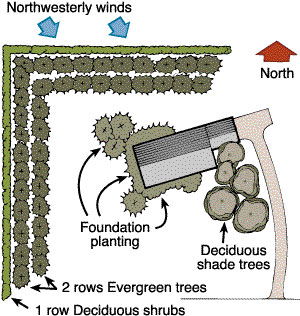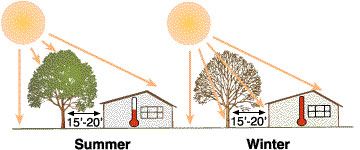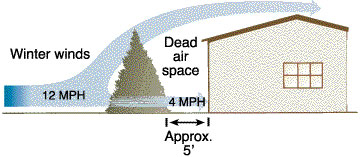 Figure 1
Figure 1
A typical plan for windbreaks.
The high cost of home heating and air conditioning often prompts homeowners to explore ways to reduce home energy use. Outdoor landscape plants, which help control erosion and are pleasing in themselves, can play a large part in controlling energy use indoors. Therefore, in addition to the beauty of landscape plantings, it is important to consider the entire landscape plan in relation to energy conservation in the home.
Windbreaks
Windbreaks reduce air movement around the home and thereby slow heat loss from the walls. The most effective windbreaks can reduce wind velocity as much as 50 percent. Windbreaks can also deflect wind movement.
The use of windbreaks for winter climate control around the home can reduce winter fuel use by 10 to 25 percent. The effectiveness of a windbreak is determined by the number of rows of plants, type of plants, height of plants, prevailing wind speeds and proper maintenance.
In Missouri, prevailing winter winds are from the north and northwest, so plant protective windbreaks to the north and northwest of the home (Figure 1). Most effective windbreaks are planted in U or L shapes. Where space allows, a windbreak should be planted to extend about 50 feet beyond each corner of the area to be protected. The most effective area of a windbreak is at a distance of four to six times the height of the trees, depending on wind speeds. However, even at a distance as much as 20 times the height of the trees, a windbreak may provide some slight benefit.
 Figure 2
Figure 2
A 20-foot-tall evergreen creates a windbreak on the northern exposure. Snow will drift 20 to 60 feet to the south or southeast.
Planting a windbreak
When planning a windbreak, remember that trees can cause snow to drift in an area that extends from their base a distance one to three times their height. If at all possible, plant the windbreak so it does not cause snowdrifts on roads, driveways and walks. For example, a 20-foot-tall windbreak of evergreen trees would provide the greatest wind reduction 80 to 120 feet to the south or southeast. Snow accumulation would be greatest 20 to 60 feet away in the same direction (Figure 2).
Although a single row of trees provides some benefit, several rows are much more effective. If space allows for only one row of trees, pines are the most satisfactory for Missouri's climate. However, pines often thin out near the ground as they mature, so them may need to be combined with a row of spreading evergreen shrubs such as yews or junipers.
Space evergreen trees in the windbreak 6 to 8 feet apart. Stagger them if planting more than one row. When several rows are used, space rows 12 to 20 feet apart, depending on the mature size of the plants.
Points to remember in planning a windbreak
- Windbreaks are most effective when plants branch to ground level.
- The wider the planting, the more effective the windbreak.
- When planting more than one row, stagger the plants.
- When using only evergreen plants, two or three rows are adequate. When using deciduous materials, four to five rows are necessary. A mixture of both types is most effective.
- Where space is adequate, plant a row of fast-growing species (such as poplar), but plan to remove them as soon as more desirable species have grown tall enough.
- When planting several rows of plants, the heights of the rows should vary to give an uneven upper edge.
- Windbreaks should allow some wind penetration. Impenetrable windbreaks create a partial vacuum on the protected side, reducing their effectiveness.
More details on developing a windbreak planting are available in MU Extension publication G5900, Planning Tree Windbreaks in Missouri.
Diverting air movement
Although windbreaks function primarily by reducing the impact of the wind, they also shift air movement. The ability of plants to divert air streams provides the greatest benefit during the summer months. Increasing the air flow in play, patio and other living areas improves summer comfort and reduces the need for air conditioning. Garden structures such as screens and fences may influence air movement, but plants add a cooling factor as water evaporates from moist leaves.
The prevailing summer winds in Missouri are from the south and southwest, so place plants to be used for channeling breezes around the house in that direction away from the home. Even the windbreak on the north-northwest side of the home channels breezes, but it may not channel them into the home or outdoor living areas in the summer. The house itself blocks air movement and channels breezes around corners if there are no barriers.
These increased air movements at corners may be used if they are directed into patios and play areas. Position plants or screens to create a funneling effect, which gathers and concentrates existing currents. This plan is more effective with light breezes because strong winds move up and over a barrier and create a different type of air movement.
 Figure 3
Figure 3
Deciduous trees on the southwest side of a house reduce indoor air temperature in summer and increase indoor air temperature in winter.
Sun and shade
The use of plants to control wind speed and movement is important for climate control and energy efficiency, but plant location in relation to the sun is also important. Choose and place plants so they do not form a barrier when direct rays of the sun are needed for warmth in winter. Rather, place plants so they provide shade for the house from the intense heat of the sun in summer (Figure 3). Deciduous trees with heavy shade cover in summer and open branching and complete loss of leaves in winter are the best choices to achieve this result.
Planting for summer shade
Because of the movement of the sun across the sky in summer, plants south and southwest of the home are most functional for providing summer shade.
The best trees for summer shade, which also produce minimum shade in the winter, are those with spreading branches and few fine twigs. Examples of such trees are ginkgo, Kentucky coffee tree, white ash and green ash. Trees selected for this use should mature large enough to throw shade on the roof of the house on a midsummer afternoon.
To shade the roof of a one-story home about 20 feet high, place the tree 15 to 20 feet from the home. Large trees should not be placed closer than 20 feet whereas medium-sized trees may be placed as close as 15 feet away.
Small, flowering trees such as redbud may be placed closer than 15 feet to provide some shade. Although they may be used for wall or window shade, they do not grow large enough to provide adequate roof shade.
Trees used for shade may also serve other purposes in the landscape.
Planting vines for shade
In some locations where space is too limited to plant trees for shade, vines may be used. Deciduous vines are most effective on southern and western walls. For masonry walls, which allow clinging species of vines to be used, Virginia creeper or Boston ivy are effective. These vines are deciduous, shading the wall in summer but dropping leaves in early fall to allow warming of the walls in winter. Clinging vines are not suitable for wood walls because they tend to hold in moisture and speed wood decomposition.
Where clinging vines cannot be used, twining vines may provide needed shade. They may be trained onto trellises placed near, but not against, the walls. Wisteria or bittersweet may be used in such locations. Even nontwining "climbers" such as climbing roses may serve this purpose when trained onto trellises.
In some locations, overhead structures such as arbors may serve a dual purpose by providing shade to patios and, at the same time, casting shade on walls and windows to keep the indoors cooler. Wisteria is a favorite vine for such overhead structures, although any vigorous, fast-growing vine is suitable.
 Figure 4
Figure 4
Evergreens adjacent to the northwest sides of a house reduce wind speed and create dead air space for insulation.
Dead air space
In addition to creating a windbreak, plants can be used to create dead air space along walls and thus provide extra insulation. Foundation planting of evergreens cuts out air movement close to the house and creates a layer of still air behind it. This still or slow-moving air forms an insulating layer that reduces the greater heat loss caused by moving air. Vines, particularly the evergreen types such as English ivy, can also reduce heat loss in the same way. This technique is particularly useful for north walls where the sun never shines (Figure 4).
Evergreen plants are most effective for foundation plantings because their insulating effect is desirable in both summer and winter. The most effective use of plants for this purpose comes from a continuous line that extends along the wall and around the corners. To achieve an attractive effect, use different kinds of plants with a variety of leaf textures, heights, forms and shades of green. Yew, juniper, mugo pine and holly are a few evergreen plants suitable for these plantings, depending on climates and suitable locations.
Natural cooling
Summer reduction of air temperature by evaporative cooling as water passes through plant leaves is also important for comfort and for reducing air conditioning needs. Large green areas or a grouping of trees produce the cooling effect of a forest. The lawn or large areas of other groundcovers provide much cooler surfaces than comparable areas of bare ground or paved surface.
To keep the air cooler, include a minimum of paved surfaces in the landscape, or locate them where they are shaded during the hottest parts of the summer day. Nonpaved surfaces should have green cover over them, either lawn, groundcover or larger plants.
Plants not only control erosion and beautify the landscape, but they also make homes more comfortable and save energy.
Original author
Ray R. Rothenberger